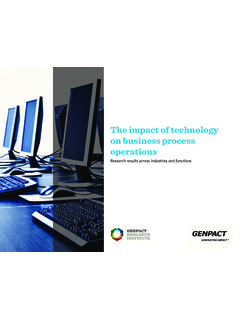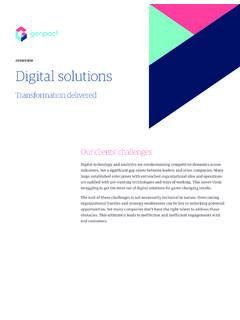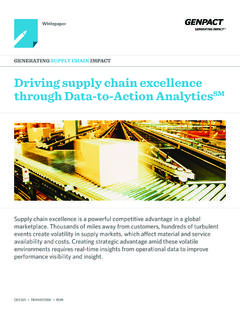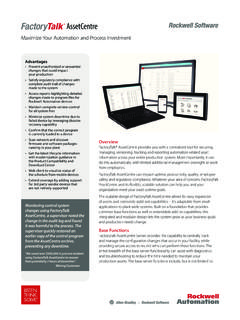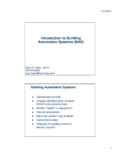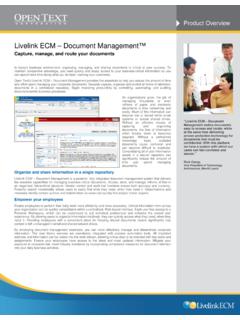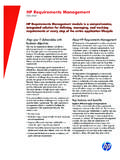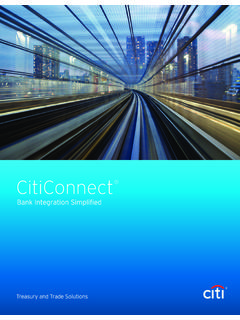Transcription of WHITEPAPER From robotic process automation to …
1 From robotic process automation to intelligent automationSix best practices to delivering value throughout the automation journeyWHITEPAPERG enpact | WHITEPAPER | 2 CONTENTSP reface .. 3 Introduction .. 4 Lay of the land .. 5 Six RPA best practices to adopt .. 6 The future beyond RPA .. 11 Genpact | WHITEPAPER | 3 Six best practices to delivering value throughout the automation journeyThe opportunity to apply robotic automation to business processes has captured the attention of many organizations as they compete in a digital-first world that requires seamless operations, and greater value from resources. By adopting robotic process automation (RPA), organizations are automating rule-based processes with software programs that do not require human interaction, and are applying them to systems, such as ERPs, workflow, and databases.
2 The next stage in the automation journey beyond RPA is intelligent automation (IA), which includes technologies such as machine learning and dynamic workflow. intelligent automation delivers exponential value by learning and adapting as it automates. While interest in RPA continues to soar, clarity on what this technology is, how it can be adopted successfully, and where it is going has not kept pace. To clear the ambiguity around RPA and its future, Genpact partnered with Zinnov, a research firm, to produce this practical paper. Encompassing the insights from over 25 interviews with RPA practitioners and subject matter experts, plus Genpact s lessons from deploying more than 1100 Bots, this guide offers best practices to organizations at all levels of maturity.
3 Looking beyond the immediate productivity benefits, we also explore how firms are impacting top-line growth as the evolution into intelligent automation includes more advanced artificial intelligence (AI), and transforms the workplace and the workforce to enhance human potential. PREFACEG enpact | WHITEPAPER | 4 INTRODUCTIONR obotic process automation has evolved significantly over recent years. When applied with systematic planning, RPA substantially improves performance and reduces the cost of operations. Most enterprise processes are manual, deterministic, and repetitive, and more than 70% can be automated using software robots. Processes that have greater complexity and require human judgment can also be automated by 15 20% through strong collaboration between software robots and human workers.
4 Figure 1 shows process complexity and automation opportunities in financial services as an processesPayment processingTrade processing and settlementsCorporate reportingTax calculation & filingFunds transfer and reviewReconciliationsAccount closureInvoice processingLoan account and credit line setupCustomer account openingData migrationInterest paymentsSetting credit limitsPeriodic accounting books closureLoan disbursementsK YC/A M L pro ce s sLoan applications processingUpdating accounts detailsRegulatory reportingCard account interchange and settlementFund accountingTrade confirmations and settlementsTransactions authorizationTax claims managementDocument processingOverdraft/advances provision managementContract complianceCredit underwritingForeclosure audit review and resolutionCollateral reviewPersonalized offers and promotionsRisk exposure monitoringInternal communication monitoringFraudulent transaction detectionCustomer queriesPersonalized financial adviceComplex processesStandardized processesComplex ProcessesIncreasing process complexityFigure 1: automation in banking and financial services processesAs automation technology evolves at an accelerated pace, enterprises are becoming more aware of the need to align their technology investments to customers needs and business outcomes.
5 For these organizations, value is captured by cutting across some of the most complex processes and using intelligent automation technologies that truly mimic human action. In this setting, process automation requires cognitive abilities, such as natural language processing, speech recognition, computer vision technology, and machine learning, to comprehend the vast amount of structured and unstructured data, learn on the go, and intelligently automate processes. As the early majority the first sizable part of a population to embrace innovative technology adopts the technology and explores new use cases, the convergence of RPA and Genpact | WHITEPAPER | 5digital is moving the goal from simply adopting robotic automation for productivity gains to achieving intelligent automation for faster, more insightful decision making.
6 Organizations that combine RPA with additional digital technologies, such as dynamic workflow, machine learning, and/or natural language processing (NLP), are realizing greater value by achieving intelligent automation . A commercial financial services firm, for example, has applied these technologies to its underwriting process for loans. NLP reads an applicant s financial statements and any information in the public domain. Dynamic workflow ensures the lender reviews the analysis with scoring models for decision-making, while robotics creates a customer profile sheet. Faster decision-making is a productivity benefit, but the bigger value lies in making more accurate customer and pricing begin our automation journey by looking at RPA.
7 Gartner predicts that by 2020, end-user spending on robotic process automation software will reach $1 billion, growing at a compound annual growth rate (CAGR) of 41% from 2015 through 2020. The forecast says that by 2020, RPA tools will have evolved to include more types of functionality, such as AI software, but will experience strong downward pricing pressure. In addition, by Overall cost reductionSpeed and productivityAccuracy and complianceScalability and flexibilityRemoval of non-value-add processes The average cost of implementing and running a robot is much less than the equivalent FTE costs and decreases with large-scale deployments RPA is typically 2X-3X faster than humans Even if robots work at same pace as humans they can work round the clock, unlike humans Robots work to 100% accuracy levels and enable compliance Avoiding human error saves costs Robots can easily be scaled up and down to handle demand fluctuations and seasonal variations Upskill the workforce to decision-making rolesFigure 2.
8 Benefits of RPA adoption for enterprises1 Gartner, Forecast Snapshot: robotic process automation , Worldwide, 2016, Tornbohm, Cathy, 30 December 20162020, 40% of very large global organizations will have adopted an RPA software tool, up from an estimated less than 10% today. 1 Some industries, like financial services and retail, have taken the lead with RPA, while manufacturing and healthcare firms have recently increased traction. Over 50% of Genpact s large enterprise clients have either invested in or are actively considering investing in OF THE LANDG enpact | WHITEPAPER | 6 There are a variety of benefits that are driving enterprises towards RPA (see figure 2). Most significant are the potential cost savings: up to 55% for deterministic, rule-based processes.
9 Speed of execution, accuracy, and compliance are other key RPA benefits for organizations, in particular for financial services firms. Retail companies looking for capacity on-demand realize that onboarding human resources for a short period of time requires considerable effort and senior leadership bandwidth; for that reason they are gravitating towards using RPA instead. Companies can also free-up human resources from low-value, repetitive work, and redirect them to higher value work that requires judgment to improve employee morale and satisfaction, which in turn further improves productivity per RPA bEST PRACTICES TO ADOPTRPA offers tremendous opportunities, but enterprises need a carefully crafted strategy and execution approach to harness them.
10 A combination of deep process expertise, technology prowess, and domain knowledge is also vital. An RPA deployment should build on six established best practices (see figure 3).RPA BESTPRACTICES123456 Prioritizebest-suited RPA use casesDeterminerealistic ROIexpectationsEstablish a well-de ned governance structureSelect capableRPA toolsand operatorsRe-engineerprocesses tomaximize RPAbene tsEnable strongcollaborationbetween thebusiness and ITFigure 3: Six RPA best practicesGenpact | WHITEPAPER | 7 Prioritize the best-suited RPA use casesIdentify the most appropriate processes for RPA by looking for deterministic and rules-based parts of a process (see 1figures 4 and 5). This will help quantify the value it can drive, and enable automation initiatives to deliver the expected results.





